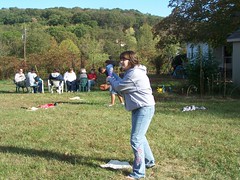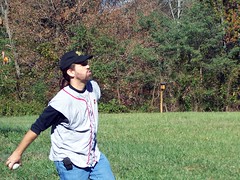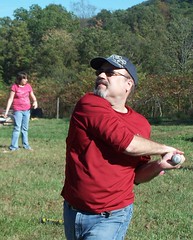Mother Ann Lee Hydroelectric Station
From a story by James Bruggers in the October 28th edition of Louisville's Courier Journal...
PLEASANT HILL, Ky. -- From a small, unassuming plant at Lock and Dam No. 7, not far from historic Shaker Village, the Kentucky River gushes across the propellers of a hydroelectric generator that will soon provide enough electricity for 2,000 homes.
The plant, located under the limestone cliffs of the river as it moves through Mercer County, was built to generate electricity in 1927 for Kentucky Utilities, but became run down and was retired in 1999.
Today, the newly named Mother Ann Lee generating station is one of four new hydropower facilities working or planned in Kentucky -- part of what some see as a step toward meeting the challenges of global warming and an increasing demand for energy security.
"We are at the beginning of a renewable energy revolution," said the plant's co-owner, [Jeff Street's own] David Brown Kinloch, a Louisville engineer. "There will be others that follow."
The plant emits no climate-warming pollution, and has been certified as having little environmental impact on the Kentucky River and its aquatic life. It sells its electricity to the Salt River Electric Cooperative, and renewable energy credits to LG&E and Kentucky Utilities.
Even in coal-dominated Kentucky, renewable energy is getting more attention as federal and state tax incentives add up, and the federal government moves closer to capping carbon dioxide emissions and making coal power more costly.
While other states have abundant wind or sunshine, making them good candidates for wind and solar power, Kentucky has substantial and consistent rainfall, and a lot of rivers. Many of the rivers are already dammed for navigation, flood control or recreation, giving the state a potentially rich hydroelectric resource.
Brown Kinloch, who has worked as an energy analyst for past Kentucky attorneys general, said there are potentially dozens more places in Kentucky where existing dams could use water power to generate electricity safely and cleanly.
In addition to the four under way, Brown Kinloch recently conducted a survey showing 20 other potential hydro projects at existing dams that have received preliminary permits from the Army Corps of Engineers or the Kentucky River Authority. Fifteen others also show potential to produce electricity, he said...
Taken together -- 2 megawatts here, 10 megawatts there -- Kentucky has enough lock-and-dam structures or flood-control dams that could be retrofitted to generate as much as 887 megawatts of electricity, according to Brown Kinloch's survey.
That would be, for example, 137 megawatts more than the proposed new unit at E.On U.S's Trimble County plant. And added up, the new hydro potential could power as many as 877,000 homes.
Brown Kinloch's contract with E.On forbids him from disclosing financial details about the Mother Ann Lee plant, and nobody has done an analysis of how much it would cost to retrofit all the dams he surveyed.
But Brown Kinloch estimates the costs of developing the 887 megawatts of hydropower could range from $1.7 billion to $4.4 billion. By comparison, The Courier-Journal reported in July that the new 750 megawatt Trimble unit will cost $1.2 billion...
Brown Kinloch and his partners have done the renovations for the Mother Ann Lee themselves -- and the work often was grueling because access is only by boat or by a 20-minute walk through the woods.
For example, they used a boat, a crane, and ropes to swing a 2,300-pound circuit breaker onto a hillside ledge. When completed, the plant will be able to be run remotely by computer.
During a recent tour of the plant, Brown Kinloch showed how one of the plant's three 20,000-pound rotors, turning 150 times a minute, runs so smoothly that he could balance a nickel on its edge.
"They call that the nickel test," he said, beaming with the pride of a parent.
Some of the work on the Mother Ann Lee is being paid for by some Kentucky Utilities and LG&E customers, through a voluntary "green energy" program.
As part of the program, residential and business customers can pay extra in monthly increments of $5 and $13 to support renewable energy and offset their "carbon footprints" -- and a portion of that goes to the Mother Ann Lee plant.
So far, 1,180 customers have signed up, said Chris Whelan of E.On U.S., the utilities' corporate parent.








